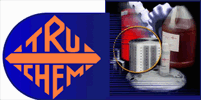

|
T.C. 1800-3 |
||||||
|
||||||
 |
 |
|
| MISSION STATEMENT | HOME |
|
|
DESCRIPTION T.C. 1800-3 is a water-soluble powder applied to metal from a solution to form a dry film drawing compound. This material combines the advantages of the polymer-type coating and the old borax-soap-type dry drawing compounds. The adhesion, rust protection, and moisture resistance of T.C. 1800-3 is far superior to the standard borax soap products. In addition, this material has the ability to make multiple and deep draws not found in the polymer-type products. As high humidity does not have the adverse effect encountered with common borax soap compounds, softening of the film (gumming) and metal corrosion with T.C. 1800-3 are negligible. Die build-up, peeling, powdering and sticking are virtually eliminated. T.C. 1800-3 was specifically formulated to obtain the high-speed application necessary for economical operation in today's industry. T.C. 1800-3 has the advantage over polymer-type products of being removed from coated stock, equipment and work areas with hot water. Disposal is both safe and simple. When application is uniform, T.C. 1800-3 leaves no lubricant marks in drawn steel parts. OPERATION Application The aqueous solution of T.C. 1800-3 is applied to the metal by either dipping, air knife, spraying or rolling. This allows flexibility in the application techniques, which is impossible with wet drawing compounds. In all methods, a uniform coating of drawing compound is easily obtained. Coated metal must be dry before stacking. Handling Sheets coated with T.C. 1800-3 do not stick together and they may be stacked for more efficient storage. Sheets may be stacked indoors for months between coating and drawing. Steel can be annealed without removing the T.C. 1800-3. Steel coated with T.C. 1800-3 may be welded without cleaning, depending upon the coating weight and welding specifications. Sheets should be properly banded to avoid accidents, as sheets coated with T.C. 1800-3 are quite slippery. Mixing Water should be added to the solution tank and heated prior to adding the chemical. The hotter the water, the quicker the T.C. 1800-3 dissolves. Temperatures above 180°F are preferred. Add with agitation and continue until the entire chemical is in the solution. Facilities Metal to be coated with T.C. 1800-3 should be clean and must enter the coating section with a metal temperature above the set point of the T.C. 1800-3 solution. Higher metal temperatures speed the drying. The metal temperature in continuous coil or cut length lines is usually obtained from a hot cleaner or hot rinse solution. In dip coating systems, heat from the T.C. 1800-3 solution itself is sufficient. Equipment should be designed to prevent T.C. 1800-3 solidification on the system by use of such items as heated coating rolls and insulated pipes and tanks. Drying of the coated metal is best accomplished by high volume, ambient to slightly warm air. In the case of dip coating, coating weights will vary inversely with solution temperature. Variation is not linear and must be determined for each production system. SPECIFICATION Concentration - 8-40 ounces per gallon, depending upon smoothness of metal, severity of the draw and coating weight desired. Rough metal and deep draws require high concentration to obtain higher coating weights.
Coating Weights - As required, generally 100-250 mg/sq ft for cold rolled steel; 200-500 mg/sq ft for hot rolled steel. Removal - T.C. 1800-3 is water soluble and cleanable in any aqueous cleaner. |